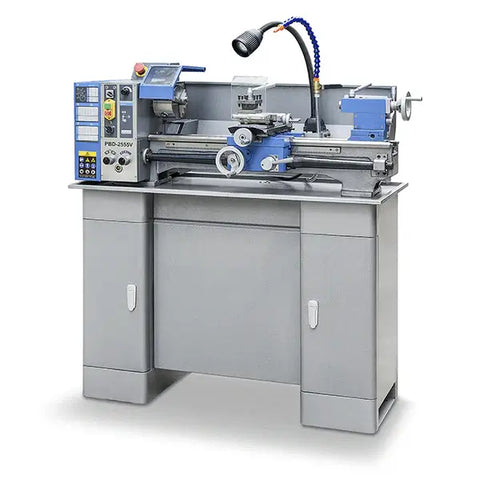
Understanding How A Lathe Machine Works | A Guide
Welcome to our comprehensive guide on understanding how a lathe machine works. Whether you are new to the world of machining or looking to expand your knowledge, this guide will provide you with the necessary information to grasp the basics of a lathe machine's operation and functions.
A lathe machine is a versatile tool used in various industries, such as manufacturing, woodworking, and metalworking. It is designed to rotate a workpiece around an axis of rotation to perform various operations like cutting, drilling, and shaping. By understanding the mechanics behind this powerful tool, you will be equipped to utilize it effectively and achieve desired outcomes.
In this guide, we will explore the different aspects of a lathe machine's operations, functions, and basic principles. From understanding the components involved to learning the techniques employed, each section will provide valuable insights to enhance your understanding of how a lathe machine works.

Key Takeaways:
- By the end of this guide, you will have a clear understanding of how a lathe machine operates and functions.
- Learning about the various parts of a lathe machine will enable you to comprehend its fundamental structure and components.
- Exploring cutting techniques used with a lathe machine will equip you with the knowledge to perform precise and accurate operations.
- Understanding the principles that govern the cutting process will help you optimize your machining efforts and achieve desired outcomes.
- Whether you are a beginner or an experienced machinist, this guide will provide valuable insights to enhance your lathe machine knowledge and skills.

Lathe Machine Parts and Cutting Techniques
In this section, we will delve deeper into the different parts of a lathe machine and discuss their functions. Understanding the various components of a lathe machine is crucial for operating it effectively. Let's explore the key parts:
1. Bed
The bed is the base of the lathe machine, providing support and stability. It is usually made of cast iron for strength and rigidity. The bed features guideways that allow the movement of various components.
2. Headstock
The headstock is located at one end of the lathe machine's bed. It houses the main spindle, which is responsible for rotating the workpiece. The headstock also contains gears and pulleys for adjusting spindle speed.
3. Tailstock
The tailstock is positioned at the other end of the lathe machine's bed. It functions as a support for the workpiece and can be moved along the bed's guideways. The tailstock may also include a spindle for additional support during machining operations.
4. Carriage
The carriage is responsible for holding and moving the cutting tool and the workpiece during machining. It consists of several essential components, including the saddle, cross-slide, and compound rest. The carriage can be manually or automatically controlled.
5. Cutting Tool
The cutting tool is a vital component of the lathe machine used to shape and remove material from the workpiece. It is held in the toolpost, which is mounted on the carriage. Different types of cutting tools are available for specific machining operations.
Now that we understand the key parts of a lathe machine, let's explore the cutting techniques used with this versatile tool. The cutting techniques employed depend on several factors, including the type of material being machined and the desired outcome. Here are a few common techniques:
1. Facing
Facing is a cutting technique used to create a smooth, flat surface perpendicular to the lathe machine's axis. It is often the first step in many machining operations and is used to prepare the workpiece for other processes.
2. Turning
Turning is a fundamental lathe machining technique used to create cylindrical shapes. The workpiece rotates while the cutting tool moves along its length, shaping the outer diameter to the desired dimensions.
3. Boring
Boring involves enlarging existing holes or creating accurately sized holes in a workpiece. It uses a special cutting tool called a boring bar that removes material from the interior of the workpiece.
4. Parting
Parting is the process of cutting off a section or separating a workpiece from the main stock. This technique is often used to create separate components or pieces with different lengths.
These are just a few examples of the cutting techniques employed with a lathe machine. The principles that govern these techniques involve precise control, tool geometry, and selecting the appropriate cutting parameters based on the material and desired outcome.
By the end of this section, you will have a good grasp of the different parts of a lathe machine and the cutting techniques that can be employed. This knowledge will enable you to effectively operate a lathe machine and achieve accurate and efficient machining results.

Conclusion
In conclusion, this comprehensive guide has provided you with a solid understanding of how a lathe machine works. We have explored its various operations, functions, and basic principles, as well as the different parts and cutting techniques involved.
By following the information shared in this guide, you can confidently operate a lathe machine, whether you are a beginner or looking to expand your knowledge. Understanding the inner workings of this versatile machine is crucial in harnessing its full potential.
Remember, the lathe machine serves as a fundamental tool in various industries, from woodworking to metalworking, enabling precision and efficiency in shaping and machining. Familiarizing yourself with its mechanics will not only improve your craftsmanship but also enhance your problem-solving skills in manufacturing processes.
So, whether you are interested in turning, facing, chamfering, or any other operation, you now possess the necessary knowledge of how lathe machines work. Embrace the wide range of possibilities this versatile machine presents and continue to explore the world of lathe operations!

